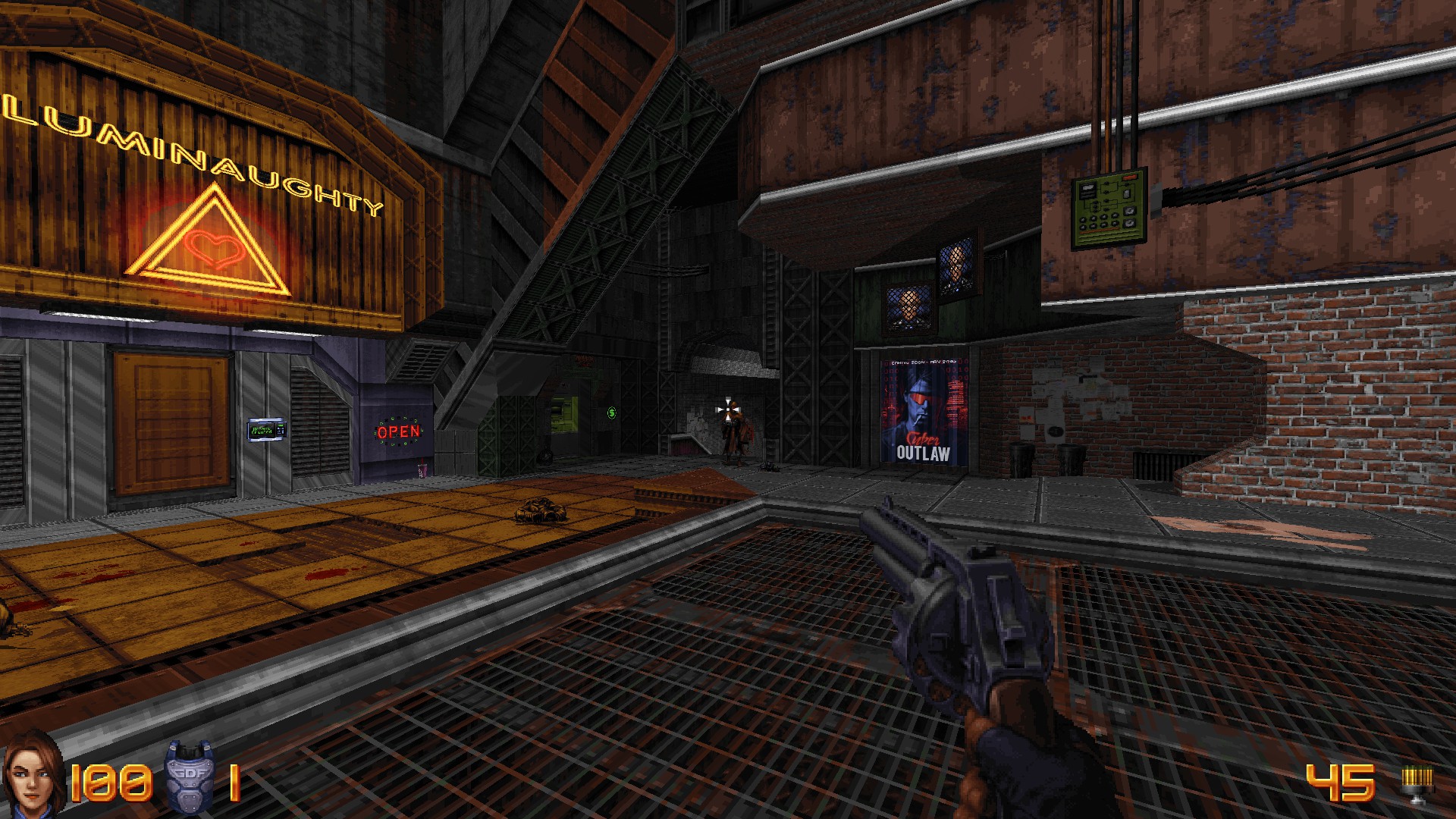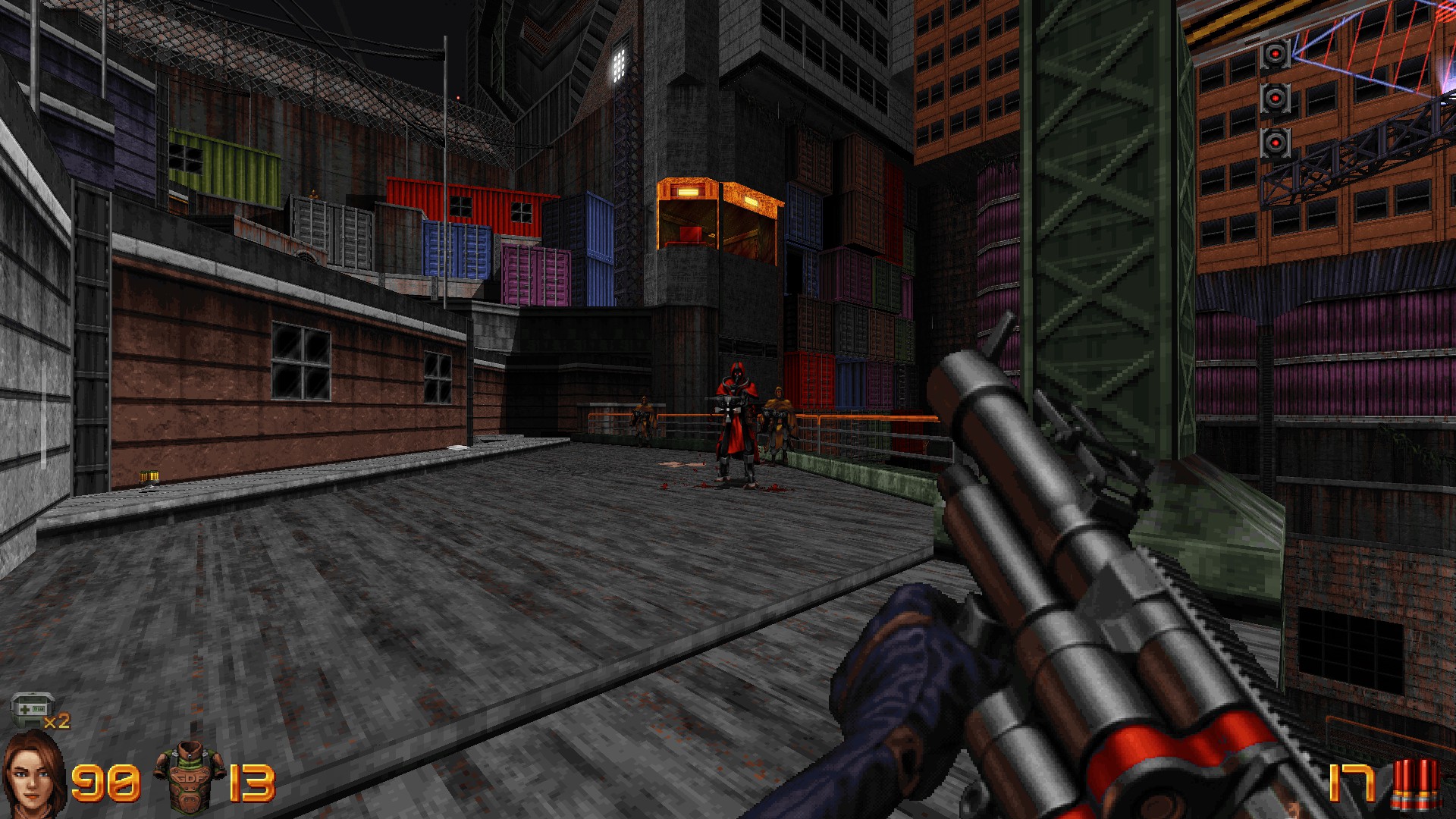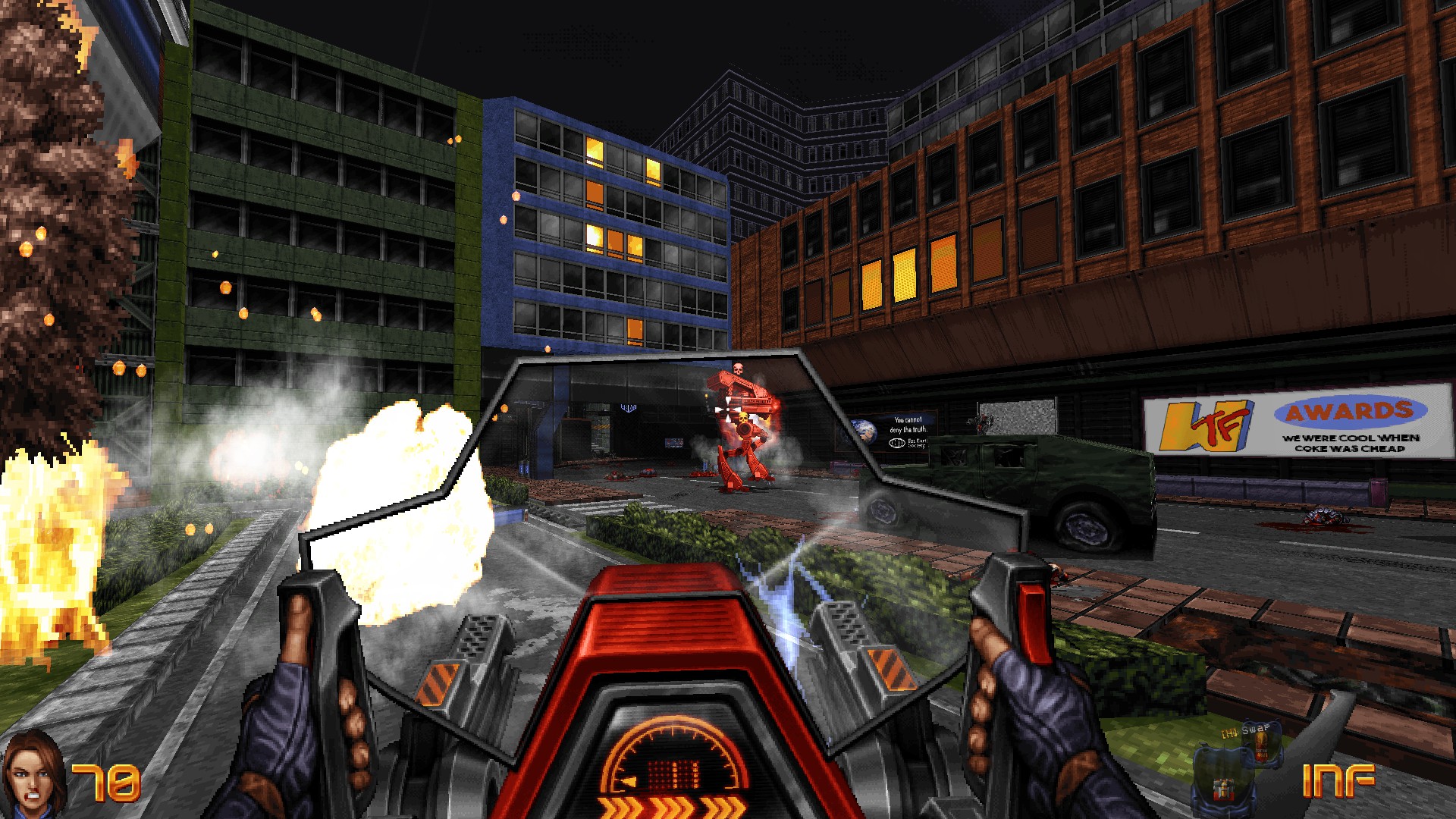Ion Fury & Ion Fury: Aftershock review
2023-10-19 by George P
Reviewed on
PCPlatforms
Playstation 4, Nintendo Switch, Xbox One, Linux, Microsoft Windows
Developer
Voidpoint LLC, General ArcadePublisher
3D Realms, Fulqrum Publishing, 1C Company
The Future Past
Ion Fury is a 90s-inspired boomer shooter featuring an action-packed campaign that aims to combine the essential elements of the genre with many of the modern innovations of the last 20 years. To set the appropriate mood, Ion Fury begins with a giant explosion and places the game’s valiant female protagonist at the heart of the action. Α malevolent transhumanist cult has invaded Neo DC with the goal of establishing a regime of absolute cybernetic tyranny. It will be your duty to repel the cult’s attack and save the city from a dystopian fate. Neo DC is composed of a mainly industrial aesthetic combined with a hefty dose of neon lights and hints of cyberpunk-ish futurism. A sense of decay and haunting emptiness permeates the atmosphere. While the environmental design is decently fitting to the old-school premise, the game’s real highlight is its level design. Brilliant level design is the hallmark of any self-respecting boomer shooter and that’s a component that Ion Fury absolutely nails.
The map is cleverly crafted around mobility and a fast-paced rhythm of shooting and dodging. Additionally, it is built to encourage exploration and discovery with the inclusion of alternate routes and a plethora of well-hidden secrets. The great level design in turn helps the gameplay loop feel exciting, challenging, and frantically engaging. Apart from level design and mobility, two other imperative gameplay elements in a boomer shooter are of course weapons and enemies. Similarly to level design, the gunplay of Ion Fury is well-thought-out and constructed with consideration to both the genre’s 90s past and its modern present. As a result, it feels snappy, energetic, smooth, and accurate. These attributes are able to produce a high skill ceiling which helps the experience, especially at higher difficulties, feel both engaging and fair. The gunplay as a whole feels remarkably modern while simultaneously maintaining the magic retro touch that Ion Fury hopes to evoke. When it comes to enemies, I would say things are slightly more underwhelming. That is without saying that the enemy design is bad. It has many of the fundamental ingredients that one would expect from a boomer shooter and it executes them very well. These include elements such as grotesque sprites, over-the-top death animations, as well as a variety of ranged and melee attack patterns. At the same time, however, I could not help but feel that most enemies were quite bland and forgettable. I think if you especially consider that the antagonist faction is supposed to be a cybernetic transhumanist cult, one would expect a more interesting and distinct enemy design!

Limitations. Charming and Provocative
There is a fact about Ion Fury that many players will find surprising. That fact that the game was developed on the Build Engine. Yes, that’s right, the 90s Build Engine that Duke Nukem 3D and Shadow Warrior were made on. Based on that, there are two relevant observations that I believe can be made in regard to Ion: Fury but also retro-inspired games in general. The first observation concerns the player. Timeless charm as well as a sense of reinvigorating nostalgia are some of the most essential aspects of retro-inspired games. These traits have acted as the primary selling points of such titles for the past decade. A decade characterized by what can only be described as a colossal wave of old-school games across all genres and niches.
What I have always considered fascinating is how this “retro wave” has managed to re-adjust our perception of what were originally considered to be limitations. The games that Ion Fury takes inspiration from were limited. Limited in terms of pixel count, colour palettes, mechanics, collisions, physics, polygon count, camera movement, lighting, and much more. This “cage” of restrictions shaped the design choices of the era’s developers. In turn, these choices defined how the games of the time looked and played. Today, however, the design choices that have revived old-school art directions (such as low-poly or pixel art) and old-school genres (such as boomer shooters) are intentional. The wave of retro-inspired games has proven that aspects that may appear restrictive can actually be wielded as useful instruments. And can ultimately lead to highly engaging and unique experiences. The second observation concerns the developers. While players identify a nostalgic old-school charm in limitations, developers encounter a tempting challenge.
Developers appear to be provoked by these old restrictions to push antiquated tools and techniques to the edge and discover their true boundaries. We can spot such a pattern in Ion Fury, where its veteran developers have decided to use an almost thirty-year-old engine while simultaneously wanting to introduce modern features to the game. But if limitations have a role in making such games appealing to players, why would developers try to overcome them? While these two observations can initially appear contradictory, they actually reveal the delicate balance that creators of such games must maintain. The balance between retro authenticity and modern calibration.

Ion Fury successfully manages to feel like an authentic 90s boomer shooter as it has all the ingredients and intentional limitations that produce a nostalgically familiar experience. At the same time however, it utilizes modern polish and optimization as well as a few contemporary mechanics (such as headshots which its predecessors did not have) to provide a smoother and more enjoyable gameplay loop. Most importantly, it introduces such modern additions in a careful manner and without undermining its fundamentally retro character. The result is an experience that not only captures the old-school charm it markets itself upon but also elegantly includes contemporary features that enhance the game as a whole.
This meticulous balance between genuine retro spirit and subtle modernization encompasses every part of Ion Fury. It is a game that most veterans of the genre will highly enjoy and will absolutely be able to appreciate its many positive qualities as outlined previously. While the game is primarily marketed towards old-time veterans, I also believe that it is a great starting point for new players who want to discover boomer shooters. With all the praise that Ion Fury has received so far in this review, one would think it is an almost flawless game. Unfortunately, that is far from the case. There are numerous negative elements in the experience that Ion Fury offers. If there was one word to summarize them, that would be: bland.
This is a game that for me did not stand out. And despite its strong points I ultimately found it forgettable. The theme, the setting, the story, and the protagonist are all flavourless and predictable. The environments of Neo DC are generally dull and many of the campaign’s different areas look very similar to one another. The overuse of boomer shooter tropes certainly helps the game appear “authentic” in the retro sense but at the same time, it makes it feel generic. While the gunplay is well-designed, the guns themselves are incredibly standard and uninspired. The same can be said for the enemy design which lacks variety and is probably one of the weakest components of the experience. To conclude, while I mostly enjoyed Ion Fury during my playthrough, I do not believe I will revisit it or remember much about it in the near future.

Ion Fury: Aftershock
On the 2nd of October 2023, Ion Fury received a DLC expansion introducing 15 new levels accompanied with numerous other gameplay additions. Aftershock aims to act as a proper conclusion to the game’s storyline (which will not be spoiled in this review) and picks up right where the original campaign left off. Let me begin by saying that the level design of Aftershock is absolutely impeccable. It is probably even better than the original campaign’s level design which is surprising to say as that was already top-notch.
Similarly to the main game, secrets of all kinds are cleverly hidden behind every nook and cranny which elicit a constant sense of awareness and curiosity. This feeling of exploration is reinforced by the more open approach to level design that Aftershock adopts. And while levels are indeed more open than their vanilla counterparts, they have plenty of tight, intense, claustrophobic segments that boomer shooters excel at. The other delightful surprise that I very much appreciated was the highly improved environmental design.
Aftershock breaks away from the bland “futuristic industrial corridor” style that was unfortunately very prevalent in the vanilla campaign. The levels of Aftershock are visually more vibrant and thematically more interesting which really helps make the experience feel more varied and memorable. A major new feature in this DLC is the “rotorcycle”, a speedy hoverbike equipped with plasma launchers. It is a rather gimmicky addition that does not add much apart from the novelty of driving a vehicle which is initially quite exciting. When you first get your hands on it you will have to race through a linear level which has been carefully designed to showcase the capabilities of the rotorcycle. As someone who usually dislikes forced vehicle segments in FPS games it is really unexpected of me to say this but I actually really enjoyed this short section.
The more vivid and expressive environmental design of Aftershock makes racing in the streets of Neo DC while blasting enemies really exciting. There is even a moment where you have to jump from a falling skyscraper to a neighbouring building which is the cherry on top of this great section. Thankfully, this is not an isolated moment. The whole of the Aftershock campaign feels more bombastically cinematic than its predecessor. A very fitting improvement thematically as Build Engine games have usually aimed to be over-the-top movie parodies. The vehicle segments do eventually get repetitive but thankfully not in a frustrating way. However, apart from a hoverbike, the rotorcycle eventually also becomes a gun.
That’s right, after a certain point you will able to utilize one of the vehicle’s plasma launchers as a handheld weapon. Apart from the rotorcycle launcher, which is the only brand-new gun in the DLC, Aftershock also introduces a couple of new alt-fires. Explosive cluster shots for the shotgun and gas grenades for the grenade launcher. Honestly, neither the new weapon nor the new alt-fires really do anything to transform the gameplay and do not feel unique. More variety in your arsenal is of course always nice to have. We can spot a similar pattern in the new enemies that Aftershock introduces. These fall into two equally dull categories: “guy with a gun” and reskinned enemies from the original campaign. Similarly, to the new weapons, these new antagonists are a welcome addition when it comes to variety.
However, they do not make the gameplay feel fresh or solve the issue of boring enemy design that was present in the main campaign. Overall, I would say that Aftershock is generally a somewhat improved version of the original Ion Fury. Most notably, in terms of environmental design and level themes. It is clear that the developers took into consideration earlier feedback and dedicated a great amount of time and attention while crafting this new campaign. Something that definitely shows in the final product. This becomes even more apparent once you consider that Aftershock was released more than four years after the original Ion Fury!
At the same time, however, while the DLC improves many of the experience’s major ingredients, it does not fundamentally change the character of the gameplay loop. At its core, Aftershock is more of Ion Fury. With all the positives and negatives that this entails. Therefore, when assessing whether this DLC would be a good purchase for you or not, fall back on your original thoughts. If you found Ion Fury’s vanilla experience engaging, then you will most likely have a great time with all the new levels, the agile rotorcycle, the improved environments, the cinematic moments, and other additions that Aftershock has to offer. If on the other side, you did not enjoy the main campaign, then it is highly unlikely that Aftershock will change your mind.
After delving into Ion Fury, I was genuinely impressed by its ability to evoke 90s nostalgia while infusing modern mechanics seamlessly. Its gameplay is smooth, boasting commendable level design and gunplay. However, it occasionally drifts into repetitiveness, making some moments feel less memorable. Then, Aftershock, the DLC expansion, entered the scene. While it mirrors many of Ion Fury's strengths and shortcomings, it shines brighter in its environmental design and thematic depth. If the original game resonated with you, Aftershock is a worthy addition. But if Ion Fury didn't click, this expansion might not sway you.